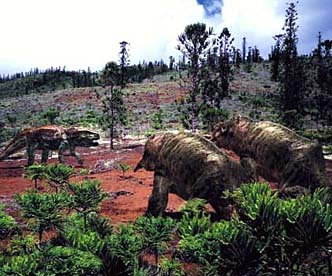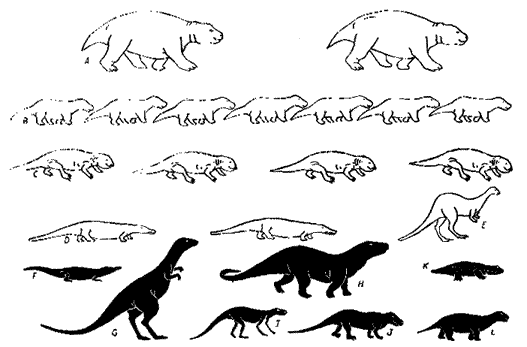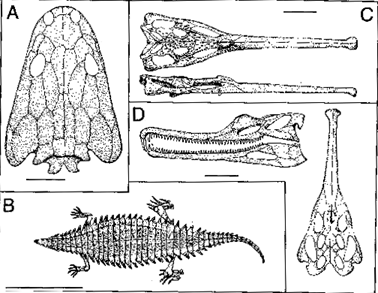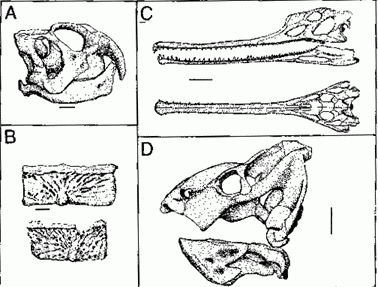
| Palaeos: Mesozoic |  |
Late Triassic epoch |
| Triassic PERIOD | Carnian Age - 1 |
| Page Back | Back: Ladinian | Back: Middle Triassic | Up: Late Triassic | Unit Home |
| Page Next | Next: Norian | Next: Early Jurassic | Timescale |
| Mesozoic Era
Triassic Period Early Triassic Epoch Middle Triassic Epoch Anisian Age Ladinian Age Late Triassic Epoch Carnian Age Norian Age Rhaetian Age Jurassic Period Cretaceous Period |
Introduction
The Geography of the Carnian The Climate of the Carnian Stratigraphy Plants Invertebrates Tetrapods - Land Faunal Stages A Carnian Bestiary |
 |
| . |
The first of the three divisions that make up the Late Triassic period, the term Carnian Stage was introduced by Mojsisovics in 1869. It is named after the Carnic Alps in Europe. The alternative spelling Karnian is sometimes used but Carnian with a C is based on the Latin and therefore more correct.
The Carnian was an important time, evolutionarily speaking. On the one hand the archosaurs - the "ruling reptiles" - have pretty much taken over the world, and include a whole host of large lizard-, crocodile-, and dinosaur-like forms. One the other hand, the therapsids or mammal-like reptiles have become progressively smaller. They are represented by several types, of which the small ictidosaurs continue on to give rise to mammals.
But the most significant creatures to appear are the dinosaurs. As yet they too were still rather small and insignificant: bipedal bird-like carnivores, insectivores, and herbivores. Most of the big animals of the time were not dinosaurs but dinosaur and crocodile-relatives, of the time: the phytosaur, ornithosuchid, prestosuchid, aetosaur, poposaur, and raiusuchid archosaurs.
As with the early Triassic world, many of these animals had world-wide distribution: the fauna of India, North America, South America, Africa, and Britain are seen from known fossils to be pretty much the same. There is however the beginning of a separation between the faunas of the North - the Laurasian supercontinent - and those of the South - the Gondwanaland supercontinent. Already, the land-masses, having barely united, were beginning to separate. Pangea itself was still to remain as a fairly coherent entity for 100 million years.
But several unique and evolutionarily very important forms did apparently develop in West Gondwanaland, or what is now South America. The earliest dinosaurs (Eoraptor, Staurikosaurus, etc), dinosaur ancestors (Lagosuchus), and crocodile ancestors (Trialestes and Gracilosuchus are known from this continent. So it seems that this was an important centre of evolution at this time.

The Carnian Age may mark the high point of Pangea. This is a difficult point to identify since, like the Roman Empire, Pangea continued to grow at the margins long after it had begun to crumble from within. We lack a Triassic Tacitus to describe "the history of a period rich in disasters." Then again, Tacitus would undoubtedly have blamed the whole business on the decadence of the cynodonts, their loss of ancient virtues, the perfidy of the debased archosauromorphs, and the primitive virility and martial spirit of the early dinosaurs. Perhaps we are better off, after all, with the stodgy, but less judgmental language of plate tectonics.
The big news of the Carnian -- and of the entire Triassic -- was the spreading ridge in the south, which had sheared off small pieces of Gondwana and was busy driving these small "Cimmerian" plates north across the Paleotethys. The exact identity of the Cimmerian lands seems to be subject to some dispute. The list may include Iran, possibly Turkey, Tibet, Indonesia and Southeast Asia. Behind them, the spreading ridge left the "new" Tethys Ocean. As the eastern end of the ridge herded the Cimmerian blocks north, the western end began to drive a wedge between Laurasia and Gondwana. This gap was filled by a long, narrow, shallow sea, the Tethys Seaway. The Tethys Seaway is well-known for the distinctive vertebrates that evolved and lived within it, particularly the Sauropterygia and Ichthyosauria. By Carnian times, the Seaway and its fauna were well-established, although the permanent rift had not yet penetrated far to the west. In between, in the region sometimes called the Vardar Ocean, collisions were already taking place between small, northward moving blocks and the European craton. Subduction of the old sea floor of the Paleotethys under the southern margin caused lifting in southeastern Europe and southern Russia. Transverse faulting associated with the Tethyan rift seems to have caused geological chaos in central Europe. Geological maps of Central Europe in this period tend to look like political maps of the same area in the Eighteenth Century. Not surprisingly, there is considerable confusion about just what was happening when -- a subject to which we will return in the discussion of climate.
While a permanent rift had not yet developed between North America and Africa or South America, the region was tectonically active. This may or may not have included a Carnian "CAMP Event," a brief catastrophic lava flow at various points along the future rift line (the "Central Atlantic Magmatic Province"), lasting less than a million years. Certainly, there were significant lava flows in Morocco as well as at the Eastern end of the Seaway. However, volcanic activity was also present in Siberia and in southwestern Gondwana. The latter was associated with another major rift, which would separate Africa and South America, on the north, from Antarctica and India, on the south. In fact, by the Carnian, the Karoo rift system in southeast Africa was well-established, and shallow seas already filled most of the rift valley.
The Siberian vulcanism was, by contrast, probably associated with continental consolidation. By the Carnian, all of the various minor blocks around Siberia, including the large Kazakhian piece, had consolidated, and the whole thing was suturing itself to the eastern end of Laurasia. This created a brick wall in the northwest, an immovable object against which the irresistible force of the Tethyan spreading ridge was batting the Cimmerian and Chinese terranes. The result was a sort of train-wreck in the Far East which eventually created the megacontinent of Asia. However, these effects were only just beginning to be felt in the Carnian. ATW03051
The Carnian appears to have been a turning point for a number of key environmental variables. Carbon dioxide was reaching a local maximum (at 250-300% of modern levels), and oxygen a local minimum (at about 50% of modern levels). Sea levels had been extremely low and quite stable since the end of the Permian. By the end of the Carnian, we see the first hints of a long-term rise in sea level which would last for a hundred million years, cresting in mid-Cretaceous times. Finally, the relatively stable, dry climates of the Early and Middle Triassic were shifting to the more strongly zonal, monsoonal climates of the Late Triassic.
There are numerous indications from the well-sampled exposures in the Chinle Formation (southwest US), the Newark Supergroup (Eastern US & Canada) and the shores of the Tethys Seaway in Europe, that a pulse of relatively humid conditions occurred during the Carnian. However, there are paradoxical indications, from the same areas, that the climate was unusually arid and intemperately hot. At some point, the Seaway itself appears to have experienced a "salinity crisis" (general evaporation) and a breakdown of the reef system.
Professor Paul Olsen and co-workers have proposed a possible solution to this problem which explains most, but not quite all, of the observations. Olsen's key observation, which seems obvious only in retrospect, is geographical. All of these well-sampled areas (a) lie along the Tethyan rift valley (b) on a more or less direct east-to-west transect (c) almost exactly on the Carnian equator. Thus, they are hardly a fair sample of what was going on in Pangea generally. Armed with this knowledge, we can sort things out fairly quickly. First, the conclusion that the Carnian was unusually arid comes from the presence of evaporites, salt deposits from evaporated seas. The stretching and transverse fracturing along the Tethyan rift zone naturally led to many short-term marine transgressions into the rift valley system before the final inundation. In between marine invasions, these temporary seas would dry out, leaving extensive evaporite deposits along the whole length of the rift from Arabia to Arizona. Because transverse fracturing was extensive, particularly in Europe, we may doubt that the timing of either evaporitic episodes or transgressions was the same in all places. For example, a brief survey of abstracts on the web yields three studies which agree that a major transgression, associated with humid conditions occurred in Carnian Italy. However, one says humid conditions appeared early in the Carnian, with the land later becoming arid. Another says the reverse. The third states that equable climates occurred in the middle of the Carnian, with a howling waste on both sides. The problem is probably not dating error, but sampling error. Along the complex and evolving system of transverse faults associated with the Tethyan spreading ridge, we may reasonably expect a great deal of local variation. In particular, evaporites are not a good indicator of climate under these conditions because the rather rapid changes in relative elevation of the splintered blocks causes temporary marine flooding and evaporation without any real change in climate or sea level.
Second, the Late Triassic did see the establishment of a zonal climate. Olsen proposes that a narrow equatorial tropic belt was already established by Carnian times. As Pangea drifted slowly northward, the lands around the Tethyan rift passed through this narrow climatic zone in just a few million years. The observed, asynchronous "pulse" of tropical climate was then a geographical artifact, not a temporal event. The equatorial belt, with its distinct, endemic ecosystem didn't disappear. It simply moved, with the equator, into the poorly known and deeply buried Late Triassic deposits of the southeastern US and northern Africa. This hypothesis is supported by the presence of flourishing higher-latitude, highly seasonal ecosystems (e.g. Ischigualasto & North China) roughly where one would expect other belts of moist conditions in a zonal world climate system.
The breakdown of the reef system in the Seaway need not have occurred during one single episode. In any case, the "event," if that is what it was, is coincident with a significant evolutionary change in reef systems. After the mass extinction at the end-Permian, the reef systems of the world were re-established (if we ignore the brief run of stromatolites in the very early Triassic) by calcareous sponges. Some time in the Middle Triassic, corals appeared. These began to replace sponges as the major reef organisms in the oceans of the world by the Late Triassic. Thus, what we see in the Seaway may be only some discontinuity in the faunal replacement of sponges by corals.
One of the more interesting things about the Carnian climate is that it has been modeled to moderately high resolution by one of the most complex computer programs known to man, the GENESIS project. One interesting prediction of the computer model is a very large seasonal temperature variation in the Pangean interior -- on the order of C 45°. This seems unreasonably large, but not completely out of the question. There is no easy way to test this prediction (or retrodiction, to be more precise), and it is probably inaccurate. Nevertheless, it is a useful reminder of one fact: there is simply no guarantee that the surface of the Earth always has been, or always will be, a place in which conventional tetrapods can comfortably survive. ATW030517.
The Carnian is the first of the three ages/stages of the Late or Upper Triassic. It is named after the Carnic Alps of Austria and Italy, by the Austro-Hungarian geologist and palaeontologist Johann August Georg Edmund Mojsisovics (1839-1907), in 1869. The alternative spelling Karnian introduced by Tozer in 1967 is not correct as it is based on German rather than Latin. [Harland W.B., et al]. Its base is defined by the first occurrence of the ammonoids Daxatina or Trachyceras, and of the conodont Metapolygnathus polygnathiformis. It ends at the base of Klamathites macrolobatus or Stikinoceras kerri ammonoid zones and the Metapolygnathus communisti or M. primitius conodont zones [ref GeoWhen database - Carnian] (which is also the start of the Norian). The Carnian is divided into two sub-stages, the older Julian and younger Tuvalian
But whilst marine correlation is pretty straight-forward, thanks to wide dispersal of pelagic and planktonic fossils like ammonoids and conodonts, correlating marine and terrestrial rocks - and hence organisms, can be more tricky.
Problem of Correlating the German Keuper series: There is some controversy over the dating of the terrestrial German Keuper, which itself serves as the standard for the other stratigraphic series, and the Marine ammonite zones. Two alternative correlations are offered. these are indicated here as A and B
| sub-stage | ammonite zone
(marine) |
Zonation of German Keuper -
interpretation A |
tetrapod zones based on
A |
Zonation of German Keuper -
interpretation B |
|
|
|
|
|
|
|
|
|
|||
|
|
|
|
|
|
|
|
|
|
|
|
|
|
|
|
Anderson & Cruikshank follow interpretation A, which shifts a large number of faunas into the early Norian; while Harland et al, Chaterjee, and Olsen and Sues go for interpretation B. Magnetostratigraphic evidence indicates the Schilfsandstein is latest Carnian in age (G. Hahn, "Palaomagnetische Untersuchangen im Schilfsandstein (Trias Km 2) Westeuropas". Geol. Rundsch. 73; 499-516). An important factor here is the discovery of Paleorhinus in marine (dilleri zone) strata, thus providing a critical tiepoint to the standard Alpine (Keuper) chronology. No doubt further discoveries will modify these correlations again. It really doesn't matter that much, because the uncertainty is only a few million years either way.
Marine and Terrestrial Straigraphy:
|
|
|
(marine) |
|
(Land Vertebrate Age) |
(terrestrial) |
|
| Carnian
Age |
|
|
|
|
|
Kieselsandstein Rote Wand |
|
|
|
|
||||
|
|
|
|
|
|||
|
|
|
|||||
|
|
|
|||||
|
|
|
|
Notes:
![]() Late Triassic Tetrapod Biochronology of Pangaea - Lucas, Hunt, & Huber, gives an important summary of tetrapod faunas of this period.
Late Triassic Tetrapod Biochronology of Pangaea - Lucas, Hunt, & Huber, gives an important summary of tetrapod faunas of this period. ![]() Carnian-Norian biochronology, correlation and biotic events of the
non-marine Triassic of North America - Huber, Lucas, & Hunt, - another interesting abstract by the
same authors on this topic
Carnian-Norian biochronology, correlation and biotic events of the
non-marine Triassic of North America - Huber, Lucas, & Hunt, - another interesting abstract by the
same authors on this topic
Ammonite zones are based on Harland, Cox, Llewellyn, Pickton, Smith and Walters, (1982) A Geological Time Scale (Cambridge University Press)
Tetrapod zones is based on J. M. Anderson & A. R. I. Cruikshank, "The Biostratigraphy of the Permian and Triassic, Part 5, a review of the classification and distribution of Permo-Triassic Tetrapods," in Paleontologica Africana, 21, 15-44 (1978); as modified according to LVF correlations in Lucas 1998 (ref below also)
LVF (Land Vertebrate faunachrons) according to S.G. Lucas, "Global Triassic tetrapod biostratigraphy and biochronology", Palaeogeography, Palaeoclimatology, Palaeoecology 143, (1998) pp.347-384
Phytosaur zones (and correlation German Keuper, south-west USA and India) are from Sankar Chatterjee, The Late Triassic Dockum Vertebrates; their stratigraphic and Paleobiological significance", in Kevin Padian (ed.) The Beginning of the Age of Dinosaurs (1986, Cambridge University Press), pp.139-150, modified according to above
Stratigraphic correlations (German Keuper, south-west USA, India and Argentina) are based on Anderson & Cruikshank, Chaterjee, and Paul E. Olsen and Hans-Dieter Sues, "Correlation of continental Late Triassic and Early Jurassic sediments, and patterns of the Triassic-Jurassic tetrapod transition", in Kevin Padian (ed.) The Beginning of the Age of Dinosaurs (1986, Cambridge University Press), pp.321-351
The Carnian terrestrial biotas were dominated by what I term the Aetosaur-Rhynchosaur-Traversodontid Community. This is so called because while almost all the previous elements of the Rhynchosaur-Traversodontid Community are present, they are now joined by the large, armour-plated and spiny aetosaurs (Family Stagonolepidae), one of the few groups to evolve herbivory.
|
 illustration from Bonaparte, 1982 |
|
A representative Aetosaur-Rhynchosaur-Traversodontid fauna - Late Carnian of South-West Gondwana ( |
This evolutionary biota, which lasted throughout the extent of the Late Carnian and into the following Early Norian age (early Carnian terrestrial faunas are very poorly known), saw a further diminishing of the therapsids, with only the traversodontids continuing in large numbers. The great kannemeyeriid dicynodonts that had remained the sole megaherbivore type throughout almost the entire Triassic, while still not uncommon, are now so diminished in diversity that in the Chinle local fauna only one big herbivore genus is common, the placerine kannemeyerid Placerias gigas (also called Placerias hesternus), and to the south in the Ischigualasto local fauna, the related Ischigualastia jenseni. However, new herbivores included not only the large aetosaurs but at least two lineages of small bipedal dinosaur.
The archosaurian carnivores of the Middle Triassic are joined by new large forms like the poposuchids and ornithosuchids, both of which were facultative bipeds (i.e. capable of both bipedal and quadrupedal walking and running), several further small gracile terrestrially adapted crocodylomorphs, as well as the very first dinosaurs, all bipedal and mostly small, and represented by the three main dinosaurian lineages of Theropoda, Sauropodomorpha, and Ornithischia. Only the theropods are carnivorous, but these are represented by several families (Staurikosauridae, Herrerasauridae, and possibly Coelophysidae). All the archosaurs - herbivores and carnivores - had an efficient, vertical limb posture superior to that of the contemporary therapsids.
Meanwhile, the rivers, lakes and swamps were populated by new types of amphibians (metoposaurs, although possible ancestors are reported from the early Triassic [Steyer 2002]) and the astonishingly crocodile-like phytosaurian archosaurs, which, unlike their terrestrial relatives, had a primitive, typically reptilian sprawling posture.
Early Late Carnian (early Tuvalian) faunas were quite cosmopolitan as evidenced by the distribution of the parasuchian Paleorhinus and the metoposaurid Buettneria/Metoposaurus [Hunt, et al, iNet], but became more provincial during the latest Carnian.
It was previously thought that the Kannemeyeriid-Rhynchosaur-Traversodontid megaherbivore assemblage died out suddenly at the end of the Carnian epoch, victims of the most serious of several mass-extinctions that rocked the Triassic world. It now seems to be the case that some of these animals continued through to the early or middle Norian, and the extinction was more gradual.
Dr Spencer Lucas (ref) divides Triassic tetrapod evolutionary communities into eight land-vertebrate faunachrons (LVF). Of these, the Berdyankian includes all of the Ladinian and possibly some of the early Carnian. The Otischalkian is a short period that encompasses the early part of the late Carnian, and the Adamanian the remainder of the Carnian. The following is a brief review of these stages, and the characteristic index fossils of each.
Whilst early Carnian marine vertebrates are well known from the Tethys, there are no unambiguous early Carnian terrestrial tetrapod-bearing formations. The Lower (Therapsid Assemblage) part of the Santa Maria Formation (Berdyankian LVF) may possibly be (or extend into) earliest Carnian, rather than a solely Ladinian as traditionally assumed. However the fauna is very endemic and so difficult to correlate. An apparently early Carnian assemblage has recently been collected from basal levels of the Isalo II in the southern Morondava Basin, near Sakaraha, in western Madagascar [Burmeister et al 2000]. These include the traversodontid Exaerpeton and other synapsids, possibly the earliest known prosauropod dinosaurs (or the earliest dinosaurs if the dating is correct), and the rhynchosaur, Isalorhynchus genovefae. Preliminary cladistic analysis of the latter suggests a placement between Middle Triassic rhynchosaurs from England and Tanzania, and the Late Carnian Hyperodepodon from Scotland and South America . [Flynn et al 1999]. There is a curious absence of the ubiquitous (from late Carnian onwards) phytosaurs and aetosaurs, although these both occur higher up in the stratigraphic sequence. However Langer et al 2000 reassigned Isalorhynchus to Hyperodapedon, and Spencer G. Lucas and Andrew B. Heckert [Lucas & Heckert 2002] argue that the Isalo II base is no older than Otischalkian (early late Carnian, see below)
 illustration from Lucas 1998
|
| Otischalkian index fossils: (A) Metoposaurus, (B) Longosuchus, (C) Paleorhinus, (D) Angistorhinus, Scale bars A , C and D are 10 cm; B is 1 meter. |
The Otischalkian is defined as the interval from the FAD (First Appearance Datum) of the phytosaur Paleorhinus/Parasuchus
up to (but not including) the FAD of the phytosaur Rutiodon. Among the widespread tetrapod index fossils of this time are the phytosaurs Paleorhinus and Angistorhinus, the aetosaur Longosuchus, the temnospondyl Metoposaurus and the small armoured archosaur
Doswellia [Lucas 1998, Lucas 1999]. Some of these forms are illustrated on the left.
Included in the Otischalkian is the Chinle Group and correlatives in south-west USA (including the type fauna found in the Colorado City Member of the Dockum Formation, Chinle Group near the defunct town of Otis Chalk, Howard County, Texas), the equivalent Sanfordian interval of the Newark Supergroup basins of eastern North America; the Schilfsandstein, Kieselsandstein, Lehrbergschichten and Blasensandstein of the German Keuper; the Irohalene Member (T4) of the Timesgadiouine Formation, Argana Group, Morocco; and basal part of Maleri Formation, Pranhita-Godavari Valley, India. [Lucas 1998, Lucas 1999] The Ischigualasto Formation of Argentina and the upper Santa Maria Formation of Brazil are dated somewhat later, largely on the basis of the single taxon Stagonolepis (Aetosauroides), but the endemic nature of fauna makes
correlation difficult, and it is not at all certain that the scrappy Santa Maria remains belong to the same species. Santa Maria forms differ on either the species or the generic level, which indicate either a high degree of endemism, or that the Upper Santa Maria Formation is slightly earlier [Bonaparte, 1982], or both
The Otischalkian is described as late Julian-early Tuvalian age based on Paleorhinus and Metoposaurus records in Tuvalian marine strata in Austria, palynostratigraphy, and magnetostratigraphy [Lucas 1998, Lucas 1999 ], or early Tuvalian only [Heckert & Lucas 2000]
 illustration from Lucas 1998
|
| Adamanian index fossils: (A) Scaphonyx, (B) Stagonolepis (paramedian plates), (C) Rutiodon, (D) Ischigualastia, Scale bars A is 1 cm, B 3 cm, C and D are 10 cm. |
The Adamanian succeeds the Otischalkian. The beginning of the Adamanian is defined as the FAD of the phytosaur Rutiodon, and it continues up to (but not including) the FAD of the phytosaur Pseudopalatus. Lucas 1998 and 1999 lists the tetrapod taxa Scaphonyx (=Hyperodepedon), Stagonolepis (including "Aetosauroides") and Rutiodon-grade phytosaurs such as Leptosuchus (possibly a synonym of Rutiodon), and Smilosuchus as useful Adamanian index fossils. However, Scaphonyx/Paradepedon/Hyperodepedon-grade rhynchosaurs are also reported from Otischalkian correlates in India and Eastern USA (Newark) [Lucas 1998]. And just because Stagonolepis is unknown from the Otischalkian of North America does not mean it did exist elsewhere at that time (diachronic appearance of the same species in different localities is a well-known phenomenon; e.g. the problem of correlating early Cambrian faunas [Brasier, 1989).
The Adamanian type vertebrate fauna is that of the Blue Mesa Member of the Petrified Forest Formation in the Petrified Forest National Park, Arizona, USA. Other major Adamanian-age vertebrate faunas are those of the Conewagian interval of the Newark Supergroup basins of eastern North America; Lossiemouth Sandstone Formation, Scotland; and the Ischigualasto Formation, Argentina and upper Santa Maria Formation, Brazil [Lucas 1998/1999] (although as I suggested it is not impossible that these may not also extend earlier)
The Adamanian can be pretty reliably dated as latest Carnian (Late Tuvalian) based mostly on palynostratigraphy and magnetostratigraphy.
| Page Back | Unit Home | Page Up | Page Top | Page Next |

Except for material otherwise attributed or quoted, all text on this page is licensed under a
Creative Commons License.
Apart from menu header and other images by MAK or ATW, and public domain gifs, all images on this page are not covered by this
license,
and are copyright their respective owner or publisher.